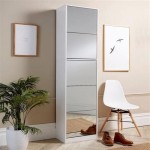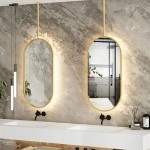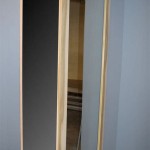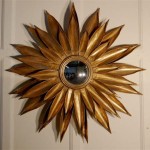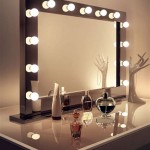What Height Should A Bathroom Vanity Mirror Be?
Selecting the correct height for a bathroom vanity mirror is crucial for both functionality and aesthetics. A well-placed mirror allows for comfortable use while contributing to the overall design of the bathroom. Several factors influence the ideal mirror height, including the height of the vanity, the height of the users, and the size of the mirror itself.
The primary consideration when determining mirror height is the height of the vanity. Standard vanity heights typically range from 30 to 36 inches. The bottom edge of the mirror should be a few inches above the backsplash or countertop, generally around 5 to 10 inches. This spacing creates a visual break and prevents water splashing directly onto the mirror's surface.
User height plays a significant role in mirror placement. The ideal height allows individuals to comfortably see their reflection from the forehead to the chin. For households with varying heights, averaging the heights of the primary users can provide a suitable compromise. In bathrooms used by children, a slightly lower placement might be more practical.
The mirror's size also influences its optimal height. Larger mirrors naturally require a greater vertical span. The center of the mirror should ideally be at eye level for the average user. For very tall individuals or large mirrors, the top edge of the mirror can extend as high as the ceiling, creating a sense of spaciousness.
Building codes and regulations often offer guidelines for mirror installation, particularly in public restrooms. These regulations typically specify minimum clearances above the floor and maximum heights to ensure accessibility for individuals with disabilities. Consulting local building codes is advisable before undertaking any bathroom renovation project involving mirror installation.
Beyond the functional aspects, the height of the mirror impacts the bathroom's overall design. A carefully chosen height can enhance the visual flow of the room. For example, a mirror hung slightly higher than standard can create an illusion of greater ceiling height. Conversely, a lower-hung, wider mirror can emphasize horizontal lines, making the bathroom appear wider.
The type of mirror also plays a role in determining the ideal height. A medicine cabinet mirror, for example, has a fixed height determined by the cabinet's dimensions. For decorative mirrors, there's more flexibility in placement, allowing for greater customization based on aesthetic preferences and user needs.
Lighting is another important factor to consider in conjunction with mirror placement. Wall-mounted sconces flanking the mirror should be positioned at eye level, approximately 60 to 66 inches above the floor. Overhead lighting should provide even illumination across the face, minimizing shadows. Proper lighting enhances visibility and complements the mirror's functionality.
When installing a mirror, accurate measurements are essential. Using a measuring tape and a level ensures precise placement. Marking the desired height on the wall before hanging the mirror helps avoid costly mistakes. Careful planning and attention to detail result in a professionally installed mirror that meets both functional and aesthetic requirements.
In bathrooms with double vanities, each mirror should be centered above its respective sink. This arrangement provides individual users with a dedicated reflection space. The height of each mirror should follow the same guidelines as for single vanities, taking into account user height and vanity height.
Framing materials can influence the perceived size and height of the mirror. A thick, ornate frame can make a mirror appear smaller and heavier, while a thin, minimalist frame can create a sense of lightness and spaciousness. The frame should complement the overall bathroom décor and enhance the mirror's aesthetic appeal.
The angle of the mirror also affects its usability. While most mirrors are hung flush against the wall, a slightly tilted mirror can improve visibility for shorter individuals, particularly children. However, tilting a mirror can also create unwanted reflections and distort the image.
Ultimately, the optimal height for a bathroom vanity mirror is a personalized decision based on individual preferences and the specific characteristics of the bathroom. Careful consideration of all the factors discussed, including vanity height, user height, mirror size, and design aesthetics, will result in a well-placed mirror that enhances both the functionality and beauty of the bathroom.

Bathroom Mirror Size Calculator

The Right Height For Your Bathroom Sinks Mirrors And More

How To Hang A Wash Basin Mirror Step By Guide Accent

The Right Height For Your Bathroom Sinks Mirrors And More

Guide To Hanging Bathroom Vanity Lighting And Mirrors Liven Design

Bathroom Mirror Size Calculator

How To Choose The Best Size Mirror Olde Good Things

How To Pick And Hang The Perfect Bathroom Mirror Roomhints

How To Pick And Hang The Perfect Bathroom Mirror Roomhints

How High To Hang A Vanity Mirror Sparrow Stoll


